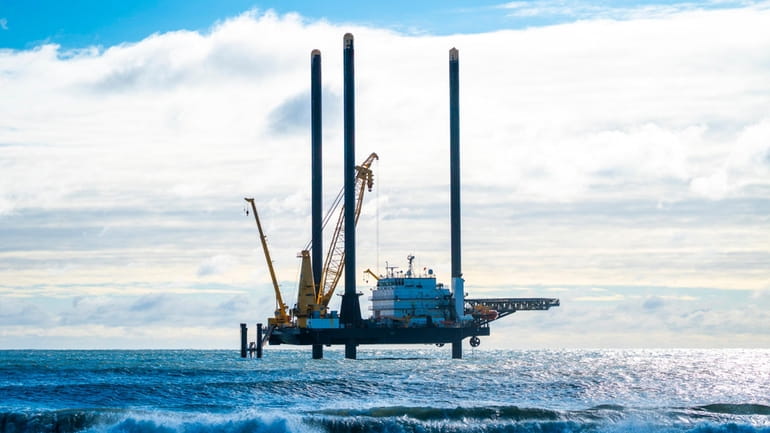LI officials must make decisions to protect against climate change

A liftboat vessel, a offshore vessel workspace for South Fork Wind, New York's first offshore wind farm in Wainscott in December 2022. Credit: Randee Daddona
A Moody Analytics report this year placed Long Island fourth among major American population centers threatened by the physical and economic risks of climate change. We rank just behind San Francisco; Cape Coral, Florida; and New York City. If not for the shared threat of severe weather, we would be in pretty good company.
Fortunately, some Long Island elected officials recognize we are at a crossroads, welcoming wind turbines off the Atlantic coast and storm-hardening crucial public infrastructure. More such leaders are needed.
This spring, Brookhaven Town officials announced a host community agreement with offshore wind company Sunrise Wind. The pact will let electrical cables come ashore carrying power from wind turbines built through the state’s renewable energy master plan. The town’s actions also turned “green” into green for taxpayers, securing millions of dollars in community and environmental benefits for Brookhaven.
A similar opportunity awaits Long Beach, Island Park, and Oceanside as the state’s mandate to phase out fossil fuel-powered generating stations will lead to a wind farm some 17 miles off Long Beach. Its power cable would make landfall at Long Beach and connect to a distribution substation in Island Park. Ironically, the substation would be in the shadow of the E.F. Barrett power plant, which has emitted greenhouse gases for generations; the project to be built by Equinor would start the plant down the road toward retirement.
These three communities would receive tens of millions of dollars from Equinor-sponsored community benefit programs following approvals of various permits required to bring the power ashore. Their elected officials will obviously seek the best terms before granting these approvals. More important, these approvals would recognize that those who live closest to an angry sea can begin to make a difference in confronting climate change. But that takes political courage.
Elected officials in these communities must realize that their actions are important not only to their own communities but to all of us who live and work on Long Island. We will either learn how to embrace and manage change, harnessing emerging “green” technologies, or we will begin to lose landmarks, and perhaps entire neighborhoods, if global warming goes unchecked.
Superstorm Sandy taught some hard-earned lessons. The storm overwhelmed two massive wastewater treatment plants along Nassau County's vulnerable South Shore. Since then, Nassau made storm-proofing these two public works a priority with regular drills to ensure that flood gates will operate on command and pump stations can process millions of gallons of waste in the face of severe weather, protecting the health of Nassau's residents. In addition, Veolia, the company that runs the plants, uses waste gases generated at these facilities to help power them.
Homes adjacent to the Bay Park plant have been raised and a number of businesses have sought to redesign their facilities so they are protected from the next storm, but this pragmatic response is far from uniform across Long Island. In too many instances, the tactic of choice is either denial or the enormously expensive and ultimately futile practice of replenishing sand dunes along the shoreline.
Unfortunately, for some Long Islanders, these are not issues of everyday concern. Yet, how we respond to climate change and rising oceans, especially in our waterfront communities, and our willingness to embrace renewable energy, will determine not only our quality of life today but what Long Island may look like for generations to come.
This guest essay reflects the views of Mitch Pally, chairman of the Long Island chapter of the League of Conservation Voters and former chief executive of the Long Island Builders Institute.
This guest essay reflects the views of This guest essay reflects the views of Mitch Pally, chairman of the Long Island chapter of the League of Conservation Voters and former chief executive of the Long Island Builders Institute.
